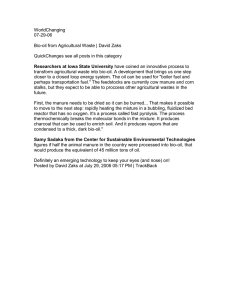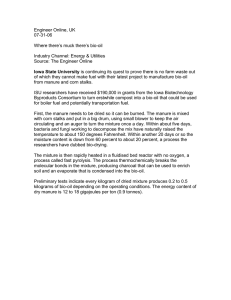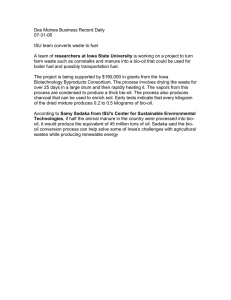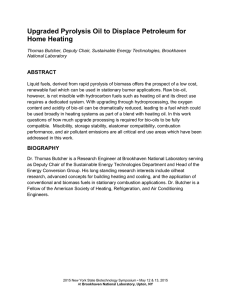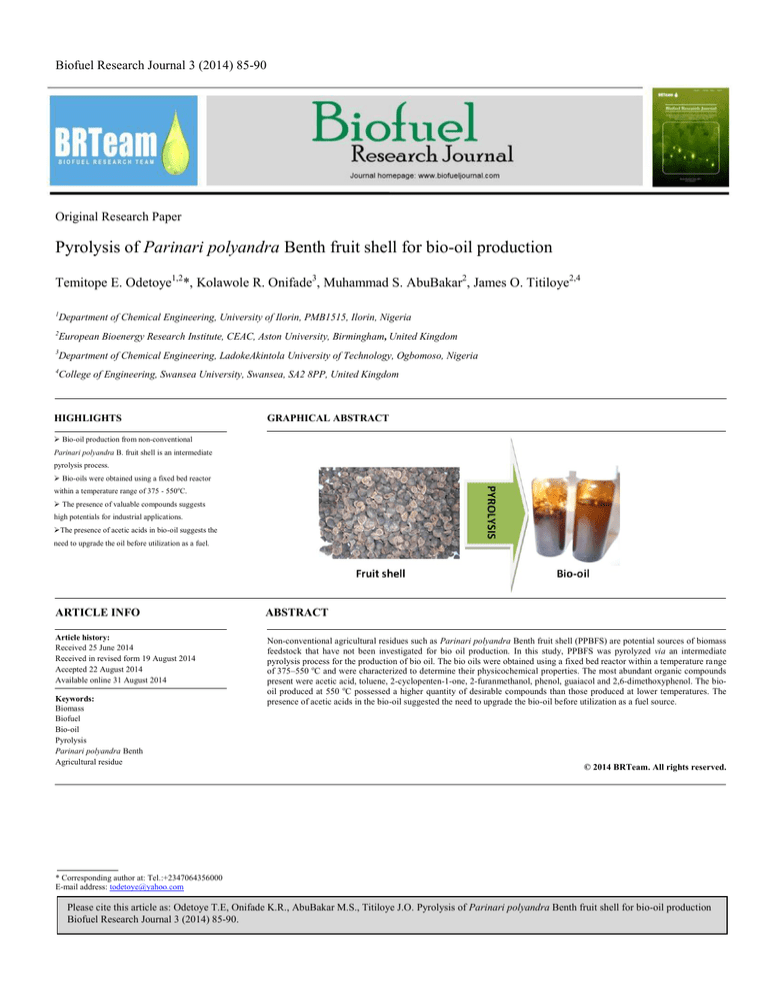
Biofuel Research Journal 3 (2014) 85-90
Original Research Paper
Pyrolysis of Parinari polyandra Benth fruit shell for bio-oil production
Temitope E. Odetoye1,2*, Kolawole R. Onifade3, Muhammad S. AbuBakar2, James O. Titiloye2,4
1
Department of Chemical Engineering, University of Ilorin, PMB1515, Ilorin, Nigeria
2
European Bioenergy Research Institute, CEAC, Aston University, Birmingham, United Kingdom
3
Department of Chemical Engineering, LadokeAkintola University of Technology, Ogbomoso, Nigeria
4
College of Engineering, Swansea University, Swansea, SA2 8PP, United Kingdom
HIGHLIGHTS
GRAPHICAL ABSTRACT
Bio-oil production from non-conventional
Parinari polyandra B. fruit shell is an intermediate
pyrolysis process.
Bio-oils were obtained using a fixed bed reactor
within a temperature range of 375 - 550oC.
The presence of valuable compounds suggests
high potentials for industrial applications.
The presence of acetic acids in bio-oil suggests the
need to upgrade the oil before utilization as a fuel.
ARTICLE INFO
ABSTRACT
Article history:
Received 25 June 2014
Received in revised form 19 August 2014
Accepted 22 August 2014
Available online 31 August 2014
Non-conventional agricultural residues such as Parinari polyandra Benth fruit shell (PPBFS) are potential sources of biomass
feedstock that have not been investigated for bio oil production. In this study, PPBFS was pyrolyzed via an intermediate
pyrolysis process for the production of bio oil. The bio oils were obtained using a fixed bed reactor within a temperature range
of 375–550 oC and were characterized to determine their physicochemical properties. The most abundant organic compounds
present were acetic acid, toluene, 2-cyclopenten-1-one, 2-furanmethanol, phenol, guaiacol and 2,6-dimethoxyphenol. The biooil produced at 550 oC possessed a higher quantity of desirable compounds than those produced at lower temperatures. The
presence of acetic acids in the bio-oil suggested the need to upgrade the bio-oil before utilization as a fuel source.
Keywords:
Biomass
Biofuel
Bio-oil
Pyrolysis
Parinari polyandra Benth
Agricultural residue
© 2014 BRTeam. All rights reserved.
* Corresponding author at: Tel.:+2347064356000
E-mail address: todetoye@yahoo.com
Please cite this article as: Odetoye T.E, Onifade K.R., AbuBakar M.S., Titiloye J.O. Pyrolysis of Parinari polyandra Benth fruit shell for bio-oil production
Biofuel Research Journal 3 (2014) 85-90.
.
86
Odetoye et al. / Biofuel Research Journal 3 (2014) 85-90
1. Introduction
There is a mounting interest in harnessing a variety of renewable resources
for energy supply (IEA, 2011; Akia et al, 2014). This is the consequence of an
increasing awareness on the need to find alternative forms of energy to
address the negative effects of the use of fossil fuels on the environment. The
growing energy needs of the world, the hike in global fuel prices as well as
the depletion of the non-renewable fossil fuel reserves are also among the
main reasons directing more research towards renewable fuels (E4tech, 2008;
Akia et al, 2014; Kumar, 2014).
Biomass which is regarded as the third world largest primary energy
resource has been a research focus for production of various types of
alternative fuels including bio-oil (Bradely, 2006). This research focus has in
turn necessitated the investigation of more biomass sources as feedstock. On
the other hand, recently there has been an increase in research interest on
biomass conversion via pyrolysis (IEA, 2011). Pyrolysis is one of the
thermochemical conversion processes involving thermal decomposition of
biomass usually above 400 oC in the absence of oxygen (Czernik and
Bridgwater, 2004).
A vast number of plant materials including energy crops and various
agricultural wastes are being considered as bio-oil feedstock (Abnisia et al.,
2011, Omar et al., 2011; Garcia et al.,2012; Greenhalf et al., 2012; Park et al,
2012; Balan et al., 2014; Beetul et al, 2014.; Kumar, 2014)..The quality of
bio-oil obtained depends on the properties of the biomass as well as operating
conditions (Park et al., 2012). Despite the fact that there have been various
research works conducted on a number of energy crops and agricultural
wastes for bio-oil production such as rice husk (Garcia et al., 2012), cassava
rhizomes (Pattiya et al., 2008), miscanthus (Hodgson et al,2010) corn stover
and bagasse among others, there is still a growing need to investigate nonconventional biomass feedstock particularly those of no other applications
such as Parinari polyandra Benth.
Parinari polyandra Benth is a savannah plant found in West Africa
extending from Mali to Sudan. It is also known as Maranthes polyandra
Benth, belonging to the family Rosasceae. The tree is about 8 m high with
glossy leaves that are elliptical and are usually rounded at both ends. The
fruits are smooth and about 2.5 cm long having a deep red or blackish purple
color depending on the variety (Fig. 1). The endosperm has a yellow white
appearance with a thick seed coat containing the oily mass. The fresh seed
kernel contains between 31-60% oil depending on the variety and season of
harvest (Olatunji et al., 1996).
has been previously characterized (Odetoye et al., 2013b; Titiloye et al.,
2013). As reported in our previous work, the thermochemical properties
obtained for parinari fruit shell determined using ASTM standard methods
including ultimate, inorganic, and proximate analyses as well as the higher
heating value of 20.5 MJ/kg were positive indicators for bio-oil production as
shown in Table 1. (Odetoye et al., 2013b).
Table1.
Proximate analysis, ultimate analysis, inorganic analysis and higher heating values of Parinari
polyandra Benth fruit shell (Odetoye et al., 2013 b).
Ultimate analysis
%
Inorganic analysis
ppm
Al
B
Ba
Ca
Cd
Cr
Cu
Fe
Hg
K
Mg
Mn
Na
Ni
P
Pb
Rb
Si
Sr
Ti
V
Zn
37
13
24
3600
ND*
2
8
92
1
11200
1700
17
54
3
1200
ND
18
164
14
4
1
10
(dry basis)
C
H
N
S
Cl
Oa
48.04
5.76
2.13
0.10
0.44
43.53
Proximate analysis
Moisture content
Ash content
Volatile content
Fixed carbon
%
2.7
4.7
78.2
17.1
Higher heating value
Bomb calorimeter
Calculated HHV1
Calculated HHV2
*ND: not detected
a
Oxygen by difference
1
(Channiwala& Parikh, 2002)
2
(Wai ,2005)
MJ/kg
20.50
18.96
18.90
(dry basis)
In this study, we report for the first time the pyrolysis of Parinari
polyandra Benth fruit shells in a fixed bed reactor and investigate its
suitability as a new feedstock for bio-oil production via intermediate
pyrolysis. To the best of our knowledge no pyrolysis work has been reported
on Parinari polyandra Benth before.
2. Materials and methods
2.1. Materials
Parinari polyandra Benth fruits were collected from trees at the University
of Ilorin, Ilorin, Nigeria (8o30′N 4 o 33′E) during the month of November. The
fruits were cut into halves to remove the seeds from the woody endocarp and
were subsequently sun-dried for five days. The dried fruits were ground
using a Retsh SM 200 heavy-duty cutting mill fitted with a 2 mm particle size
screen. The samples were characterized and compared to other similar
biomasses.
2.2. Methods
2.2.1. Pyrolysis procedure
Fig.1. Parinari polyandra Benth fruits: (a) fresh (b) dried (c) without seed, and (d) milled.
Parinari polyandra Benth is currently very much under-utilized partly due
to its non-edibility and also owing to lack of extensive research on the fruit
and seeds. The main utilization has been that of the plants parts for tradomedicinal purposes (Iweala & Oludare, 2011). Although, the seed oil is
considered not edible, it has been found to be suitable for preparation of alkyd
resins of desirable properties (Odetoye et al., 2013a, Odetoye et al., 2014).
The fruit shell, being a major waste generated from the seed oil utilization,
The intermediate pyrolysis experiments were carried out on a bench scale
fixed-bed reactor at reaction temperatures of 550, 450 and 375 oC. The reactor
was made of quartz glass tube with an internal diameter of 30 mm and a
height of 390 mm. It was connected to a primary condenser used for the
collection of condensable bio-oil. The non-condensable gases released were
scrubbed with isopropanol before sending a stream of the gases to the GCTCD HP Series II and the remaining gases vented through the fume cupboard.
The experimental set up is as shown in Figure 2. Nitrogen gas flow into
the reactor was maintained at a flow rate of 50 cm 3/min. The heating rate of
the reactor was 25oC/min. The bio-oils were obtained from the oil pots,
Please cite this article as: Odetoye T.E, Onifade K.R., AbuBakar M.S., Titiloye J.O. Pyrolysis of Parinari polyandra Benth fruit shell for bio-oil production
Biofuel Research Journal 3 (2014) 85-90.
.
87
Odetoye et al. / Biofuel Research Journal 3 (2014) 85-90
condenser and the connecting tube after each experimental run. The bio-oil
produced was initially in a gaseous phase when leaving the reactor at a
relatively fast rate due to the high temperatures used. On reaching the bottlelike condensers filled with dry ice, the condensable gases turned into liquid in
the condenser. The secondary condenser implemented in the system ensured
that the adequate condensation was achieved. The bio-oil samples used for the
subsequent analyses were collected mainly from the oil pot and the
condensers without the use of a solvent.
3. Results and discussion
3.1. Effect of temperature on yield
As shown in Figure 3, relatively higher liquid yield was obtained when the
pyrolysis experiment was run at 550 oC compared to 375 and 450 oC
suggesting that the liquid product yield increased by increasing the
temperature. The 550 oC run was also characterized with relatively lower char
content of 35.6%, while the highest char content of the product was obtained
at 375 oC.
Fig.2. Experimental set up for intermediate pyrolysis experiment
The bio-oil yield was calculated considering the oil entrapped in the
glassware condensers, by weighing each part of the glassware apparatus
before and after each pyrolysis experiment. The biochar yield was also
measured by weighing the reactor tube and the reactor head before and after
the reaction since the char (solid) remained mainly in the reactor tube and
head after the reaction. The mass of the non-condensable gases was obtained
by difference. The effects of reaction temperatures (375, 450 and 550 oC) on
products yield and properties were also investigated
2.3. Bio-oil characterization
The bio-oil products obtained were characterized to determine their quality
and composition.
2.3.1. Density, pH and water content determinations
The pH values of the bio-oils prepared were determined using a Sartorius
pH meter model PB-11. Mettler Toledo Portable Lab Densimeter was used to
determine the density of the bio-oil samples. Water content was determined
using the Karl Fischer volumetric titration method based on the ASTM D1744
standard
2.3.2. Heating value and elemental analysis
Fig.3. Product yield distribution of Parinari fruit shell obtained through pyrolysis at different
temperatures
The liquid and char products obtained at 450 oC were of comparable
values. The liquid product yield tended to increase with the rise in process
temperature. This trend observed in the product yield distribution is similar to
the pyrolysis results obtained by Volli and Singh for sesame, mustard and
neem de-oiled cakes (Volli&Singh, 2012). The relatively higher temperature
required for the parinari biomass to decompose into favorable liquid product
may be due to the high lignin concentration of 30 wt. % yielding phenols and
phenolic compounds (Kim et al., 2012; Titiloye et al., 2013).
The biochar yield at 450 and 550 oC are relatively close in percentage
value. This observation is actually in line with the thermogravimetric analysis
result reported in our earlier work (Odetoye et al., 2013b). In fact, the
decomposition of cellulose and hemicellulose which are the main components
occurred before 450 oC while lignin decomposition occurred relatively slower
at around 400 oC, hence, little difference was observed in the biochar yield
after 400 oC.
The elemental analysis of the parinari shell bio-oil was carried out by
MEDAC Ltd. Surrey, U.K. A unified correlation approach was employed to
calculate the higher heating values (HHV) using an empirical equation
suggested by Saiduret al.(2011):
HHV = 0.3516 (C)+1.16225 (H)−0.1109 (O)+0.0628 (N)+0.10465 (S)
(Eq. 1)
2.3.3. Gas chromatograph-mass spectrometer (GC-MS) analysis
The composition of the bio-oil produced was determined using the Hewlett
Packard 5890 Series II Gas Chromatograph equipped with a Hewlett Packard
5972 mass selective detector. Helium was used as the carrier gas with a DB
1706 non-polar capillary column. The initial oven temperature was 40 °C and
ramped up to 290 °C at a rate of 3 °C/min. The injection temperature was held
at 310 °C with a volume of 5µl. The dilution solvent used was ethanol and the
dilution rate was 1:5. Identification of compounds in the spectral and
chromatograph data was done with the aid of NIST mass spectra database.
Fig.4. Parinari polyandra fruit shell bio-oil samples
Please cite this article as: Odetoye T.E, Onifade K.R., AbuBakar M.S., Titiloye J.O. Pyrolysis of Parinari polyandra Benth fruit shell for bio-oil production
Biofuel Research Journal 3 (2014) 85-90.
.
88
Odetoye et al. / Biofuel Research Journal 3 (2014) 85-90
3.2. Bio-oil characterization
The bio-oil samples obtained were dark brown in colour (Fig.4) and were
composed of aqueous and organic phases which were relatively semihomogenous. The liquids were observed to separate completely into 2 phases
when stored. The parinari bio-oil exhibited homogenous characteristics and
free flowing properties. The pH of the bio-oil tended to increase with
increasing processing temperature and the sample prepared at 550 oC had the
highest pH of 4.56 (Table 2).
Table 2.
Some of the physical and chemical properties of the bio-oil prepared (organic phase)
Properties
pH
Density
Water content
Elemental composition
C
H
N
O*
S
Cl
HHV
Empirical Formula
H/C molar ratio
O/C molar ratio
Unit
375 o C
450 o C
550 o C
g/cm3
wt %
4.12
1.043
13.995
4.32
1.027
16.17
4.56
1.021
14.78
44.74
9.15
1.27
44.27
0.52
<0.05
21.85
CH2.45O0.74N0.02
66.43
8.28
2.73
21.38
0.79
0.42
30.76
CH1.5O0.24N0.04
69.31
8.97
2.89
18.79
0.73
<0.05
32.84
CH1.55O0.20N0.04
2.5
0.74
1.5
0.24
1.6
0.2
wt %
MJ/kg
The calculated heating value of 30.76 MJ/kg for the bio-oil obtained
through pyrolysis at 450 °C was comparable to those of some other biomasses
reported in the literature. More specifically, it is slightly higher than 26.22
MJ/kg obtained for corncob (Demiralet al., 2012) and comparable to the 30
MJ/kg of neem seed cake bio-oil (Volli & Singh, 2012). The elemental
analysis of the parinari bio-oil showed that the oxygen content decreased as
the pyrolysis temperature increased, suggesting the deoxygenation reaction
taking place. The chlorine content was relatively higher while the sulphur
content was desirably low in parinari bio-oil. Hence, there is a lower risk of
sulphur dioxide formation.
3.3. Bio-oil chemical composition
Abundance
The bio-oils consisted of a complex mixture of various compounds. The
GC-MS chromatogram for a typical parinari fruit shell sample pyrolysis oil is
shown in Figure 5. The most prominent peaks identified, corresponding
chemical names, retention times, chemical formula, molecular weights and
peak areas measured are summarised in Table 3 and Figures 6, 7, 8 and 9. The
identified compounds included alkenes, phenols, carboxylic acids and their
derivatives reported for the bio-oils obtained from some other biomasses
(Volli & Singh, 2012). As presented in Figure5, the main constituents in
parinari bio-oil were acetic acid, toluene, 2-cyclopenten-1-one, 2furanmethanol, phenol, guaiacol and 2,6-dimethoxyphenolas. Phenolic
compounds such as guaiacol and 2,6-dimethoxyphenol are among the
valuable components that can be obtained from bio-oil (Demiral et al, 2012)
Table 3.
Most prominent identified compounds of Parinari bio-oil
Peak
ID
RT (min)
Compound Name
Formulae
RMM*
Area
%
375°C
Area
%
450°C
Area
%
550°C
1
2
3
4
5
6
7
8
9
10
11
6.048
6.772
8.083
8.336
9.083
10.267
10.784
11.509
13.429
14.372
14.51
C5H6O
C4H8O
C5H10O
C6H8O
C2H4O2
C3H6O2
C7H8
C5H5N
C3H6O2
C5H8O
C4H8O2
82.10
72.11
86.13
96.13
60.05
74.08
92.14
79.10
74.08
84.12
88.11
0.51
0.71
0.25
0.15
18.96
1.18
0.65
0.73
1.6
0.62
1.1
0.96
1.45
0.38
0.53
18.2
0.8
3.67
1.29
2
1.7
0.76
1.25
1.38
0.29
0.49
13.4
0.66
5.28
0.77
1.21
1.43
-
12
13
14
15
16
17
15.05
15.441
16.464
16.901
17.269
17.603
C8H10
C8H10
C6H10O
C8H10
C8H8
C5H6O
106.17
106.17
98.14
106.17
104.15
82.10
0.21
4.03
0.82
0.7
0.28
0.28
0.57
4.51
1.32
1.54
0.33
0.6
0.75
3.84
18
19
19.936
20.661
C5H6O2
C6H8O
98.10
96.13
5.98
1.31
4.66
2.09
3.76
2.23
20
21.431
2-methylfuran
2-butanone
2-methylbutanal
2,5-Dimethylfuran
Acetic Acid
Hydroxyacetone
Toluene
Pyridine
Propanoic acid
Cyclopentanone
1-hydroxy-2butanone
Ethylbenzene
p-Xylene
Cyclohexanone
m-Xylene
Styrene
2-Cyclopenten-1one
2-Furanmethanol
2-Cyclopenten-1one, 2-methyl2-Furyl Methyl
Ketone
2-hydroxy-2cyclopenten-1-one
3-Methyl-2Cyclopentenone
Tetrahydro-2furanmethanol
2,4-dimethyl-2oxazoline-4methanol
Maple lactone / 2hydroxy-3-methyl2-cyclopenten-1one
Phenol
Guaiacol
2-Methylphenol
3-Ethyl-2-hydroxy2-cyclopenten-1one
p-cresol
m-Cresol
Isocreosol / 5methylguaiacol
2,4-Dimethylphenol
4-Ethylphenol
Dianhydromannitol
4-Ethylguaiacol
1,4:3,6-dianhydroa-d-glucopyranose
2,6Dimethoxyphenol
Isoeugenol
4-methoxy-3(methoxymethyl)phenol
1,2,3-trimethoxy-5methylbenzene
2,4-hexadienedioic
acid, 3,4-diethyl-,
dimethyl ester,
(EZ)4-Allyl-2,6dimethoxyphenol
C6H6O2
110.11
1.27
1.33
1.22
21
23.535
22
25.731
23
26.226
24
27.249
25
28.813
26
27
28
29
30.353
31.377
32.883
33.4
30
31
32
34.619
34.711
36.585
33
34
35
36
37
37.01
39.045
40.161
40.666
41.862
38
45.576
39
40
49.175
49.623
41
52.762
42
55.924
43
60.155
TOTAL
C5H6O2
98.00
1.09
0.72
-
C6H8O
96.13
1.84
2.67
2.55
C5H10O2
102.13
2
1.12
1.13
C6H11NO2
129.16
0.23
1.38
0.82
C6H8O2
112.13
4.28
3.62
3.48
C6H6O
C7H8O2
C7H8O
C7H10O2
94.11
124.14
108.14
126.15
1.11
5.39
0.36
1.45
2.06
3.86
1.04
0.91
4.19
3.49
2.36
0.81
C7H8O
C7H8O
C8H10O2
108.14
108.14
138.17
0.55
0.37
1.38
0.83
1.33
0.91
1.51
3.58
0.8
C8H10O
C8H10O
C6H10O4
C9H12O2
C6H8O4
122.16
122.16
146.14
152.19
144.13
0.29
1.06
1.64
1.02
0.65
0.2
0.95
1.29
0.68
1.6
0.5
0.76
1.33
0.65
C8H10O3
154.17
5.51
2.44
2.23
C10H12O2
C9H12O3
164.20
168.19
1.36
2.29
0.55
0.98
0.9
1.24
C10H14O3
182.22
2.05
1.12
1.23
C12H18O4
226.00
-
0.47
0.52
C11H14O3
194.23
1.34
0.57
0.92
75.87
77.33
78.35
*Relative molecular mass
Retention Time
Fig.5. A typical GC-MS chromatogram for Parinari polyandra bio-oil
Please cite this article as: Odetoye T.E, Onifade K.R., AbuBakar M.S., Titiloye J.O. Pyrolysis of Parinari polyandra Benth fruit shell for bio-oil production
Biofuel Research Journal 3 (2014) 85-90.
.
89
Odetoye et al. / Biofuel Research Journal 3 (2014) 85-90
Fig.6. Main chemical constituents of Parinari fruit shell bio-oil.
Fig.9. Main BTX aromatic hydrocarbons in Parinari fruit shell bio-oil.
The highest temperature of 550 oC favored the production of phenolic
compounds and their derivatives while the oxygenated phenolic derivatives
were produced at lowest temperature of 375 oC. The significant presence of
phenolics and aromatics in the bio-oil can be attributed to lignin which is a
phenolic bio-polymer (Park et al., 2012). Acetic acid is the main organic acid
contributing up to 19% peak area. The presence of these organic acids is
associated with low pH values measured for the bio-oil and are generally
known to be undesirable in bio-oils. The increase in pH achieved by
increasing the pyrolysis temperature correlated with the decrease in the acetic
acid peak area as detected by GC.
This suggests that higher temperature of 550 oC was more favourable for
the preparation of bio-oil resulting in less acidity. Furthermore, the relatively
high content of acetic acid suggests that the bio-oil may need to be upgraded
before it can be used as fuel in engines. BTX and related xylene derivatives
compounds (Fig. 9) were found to increase with increasing temperature with
the exception of 1,2,3 trimethoxy-5-methylbenzene which showed an increase
at 375 oC.
Fig.7. Main ketone constituents in Parinari fruit shell bio-oil.
4. Conclusion
Bio-oil has been successfully produced from Parinari polyandra Benth
fruit shell using an intermediate pyrolysis process. The properties of the biooil obtained herein was favorably comparable with those of other bio-oils
reported in the literature. The findings of the present study revealed that the
pyrolysis temperature had a significant effect on the properties and quality of
bio-oil obtained from Parinari seed shell. More specifically, the bio-oil
produced at 550 oC had more desirable properties than those produced at 375
and 450 oC. However, the PPBFS bio-oil needs to be upgraded before it can
be utilized as a fuel substitute particularly in engines as it consisted of various
complex organic compounds such as acetic acid. Finally, due to the
availability of PPBFS as a biomass feedstock, the parinari bio-oil is strongly
suggested to be used as an alternative biofuel. Moreover, the presence of
valuable compounds such as phenolic compounds in the produced bio-oil
indicates potentials industrial applications as well.
5. Acknowledgments
The authors express their gratitude for the financial support provided by
the School of Engineering and Applied Science, Aston University,
Birmingham, U.K.
Fig.8. Phenol and its derivatives in Parinari fruit shell bio-oil.
References
Abnisia, F, WanDaud, W.M.A., Shu, J.N., 2011. Optimization and
characterization studies on bio-oil production from palm shell by pyrolysis
using response surface technology. Biomass Bioenerg. 35, 3604-3616.
Please cite this article as: Odetoye T.E, Onifade K.R., AbuBakar M.S., Titiloye J.O. Pyrolysis of Parinari polyandra Benth fruit shell for bio-oil production
Biofuel Research Journal 3 (2014) 85-90.
.
90
Odetoye et al. / Biofuel Research Journal 3 (2014) 85-90
Akia, M., Yazdani, F., Motaee, E., Han, D., Arandiyan, H., 2014. A review on
conversion of biomass to biofuel by nanocatalysts. Biofuel Res. J. 1, 16-25.
ASTM Standard D1744, Standard Test Method for Determination of Water in
Liquid Petroleum Products by Karl Fisher Reagent, ASTM International,
United States.
Balan, V., Chiaramonti, D., Kumar, S., 2013. Review of US and EU
initiatives toward development, demonstration, and commercialization of
lignocellulosic biofuels. Biofuels, Bioprod. Biorefin. 7(6),733-760.
Beetul, K., Sadally, S.B., Hossenkhan, N., Puchooa, D., 2014. An
investigation of biodiesel production from microalgae found in Mauritian
waters. Biofuel Res. J. 2,58-64.
Bradley, D., 2006. IEA Bioenergy Task 40- Climate change solutions
European market study for bio-oil (pyrolysis oil). IEA Bioenergy Task 40Bio-trade report. p1-85.
Czernik, S., Bridgwater, A.V., 2004. Overview of applications of biomass fast
pyrolysis oil. Energ. Fuel. 18, 590-598.
Demiral, I., Eryazıcı, A., Sensoz, A., 2012. 2012Bio-oil production from
pyrolysis of corn-cob (Zea mays L.). Biomass Bioenerg. 36,43-49.
E4tech Report, 2008. Biofuel Review: Advanced technologies overview. p112.
Garcia, R., Pizarro, C., Lavin, A.G., Bueno, J.L., 2012. Characterization of
Spanish biomass waste for energy use. Bioresour. Technol. 103,249- 258.
Greenhalf, C.E., Nowakowski, D.J., Bridgwater, A.V., Titiloye, J., Yates, N.,
Richie, A., Shield, I., 2012. Thermochemical Characterisation of Straws and
High Yielding Perennial Grasses. Ind. Crop. Prod. 36, 449-459.
Greenhalf, C.E., Nowakowski, D.J., Harms, A.B., Titiloye, J.O., Bridgwater,
A.V., 2012. Sequential pyrolysis of willow SRC at low and high heating
rates – Implications for selective pyrolysis. Fuel. 93, 692-702.
Hodgson, E.M., Lister, S.J., Bridgewater, A.V., Clifton-Brown, J., Donnison,
I.S., 2010. Genotypic and environmentally derived variation in the cell wall
composition of Miscanthusin relation to its use as a biomass feedstock.
Biomass Bioenerg. 34, 652 - 660.
International Energy Agency (IEA) Report, 2011. Biofuel for transport
technology roadmap. p1-56.
Iweala, E.E., Oludare, F.D., 2011. Hypoglycemic effects,biochemical and
histological changes of Spondiasmombin Linn. andParinari polyandra
Benth Seeds ethanolicextractinalloxan-induced diabetic rats. J. Pharm.
Toxicology. 6, 101-112.
Kim, S., Jung, S., Kim J., 2010. Fast pyrolysis of palm kernel shells:
Influence of operation parameters on the bio-oil yield and the yield of
phenol and phenolic compounds. Bioresour. Technol. 01,9294-9300.
Kumar, S., 2014. Hydrothermal Processing of Biomass for Biofuels. Biofuel
Res. J. 1(2), 43.
Odetoye, T.E., Onifade, K.R., Abu Bakar, M.S., Titiloye, J.O., 2013.
Thermochemical characterization of Parinari polyandra Benth fruit shell
for bio-oil production. Ind. Crop. Prod., 44, 62-66.
Odetoye, T.E., Ogunniyi, D.S. Olatunji, G.A., 2013.Studies on the preparation
of Parinari polyandra Benthseed oil alkyd resins. J. Appl. Polym. Sci.
1276, 4610-4616.
Odetoye, T.E., Ogunniyi, D.S., Olatunji, G.A., 2014. Refining and
Characterization of Parinari polyandra Benth seed oil for Industrial
Utilization. Nig. J. Pure Appl. Sci., 27 (in press).
Olatunji, G.A., Ogunleye, A.J., Lawani, S.A.,1996. Studies on the seed oil of
Parinari polyandra Benth; Proximate Chemical composition.Nig. J. Pure &
Appl. Sci., 6, 177-179.
Omar, R., Idris, A., Yunus, R., Khalid, K., Isma, M.I., 2011. Characterization
of empty fruit bunch for microwave –assisted pyrolysis. Fuel 90, 15361544.
Park, Y., Yoo, M.L., Lee, H.W., Park, S.H., Jung, S., Park, S., Kim, S., 2012.
Effect of operation conditions on pyrolysis characteristics of agricultural
residues. Renew. Energ. 42,125-130.
Pattiya, A., Titiloye, J.O., Bridgwater, A.V., 2008. Fast pyrolysis of cassava
rhizome in the presence of catalysts. J. Anal. Appl. Pyrol. 81,72-79.
Saidur, R., Abdelaziz, E.A., Demirbas, A., Hossain, M.S., Mekhilef, S., 2011.
A review on biomass as a fuel for boilers, Renew. Sustain. Energ. Rev.
15(5), 2262-2289.
Titiloye, J.O., Abu Bakar, M.S., Odetoye, T.E.,2013. Thermochemical
Characterisation of Agricultural Wastes from West Africa. Ind. Crop. Prod.
47, 199- 203.
Volli, V., Singh, R.K., 2012. Production of bio-oil from de-oiled cakes by
thermal pyrolysis. Fuel. 96, 579-585.
White, J.E., Catallo, W.J., Legendre, B.L., 2011. Biomass pyrolysis kinetics:
A comparative critical review with relevant agricultural residue case
studies. J. Anal. Appl. Pyrol. 91,1–33.
Please cite this article as: Odetoye T.E, Onifade K.R., AbuBakar M.S., Titiloye J.O. Pyrolysis of Parinari polyandra Benth fruit shell for bio-oil production
Biofuel Research Journal 3 (2014) 85-90.
.

